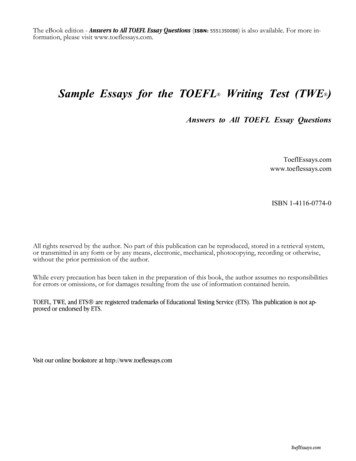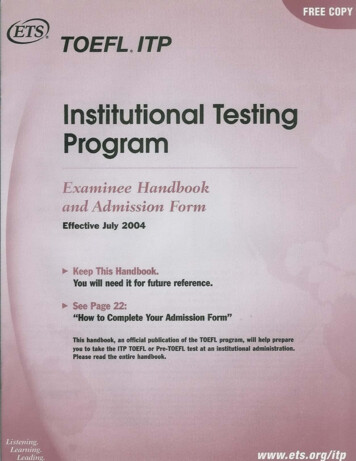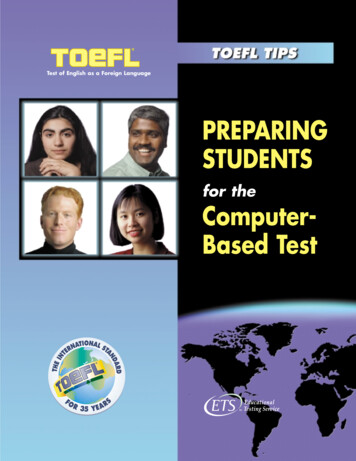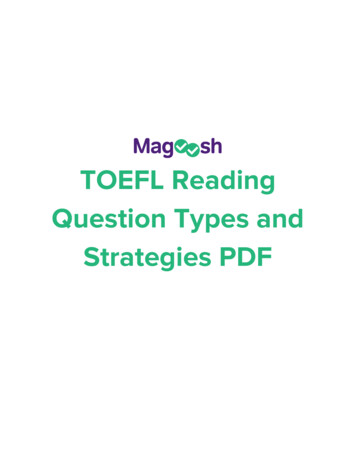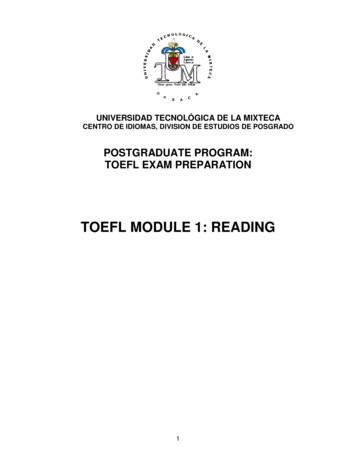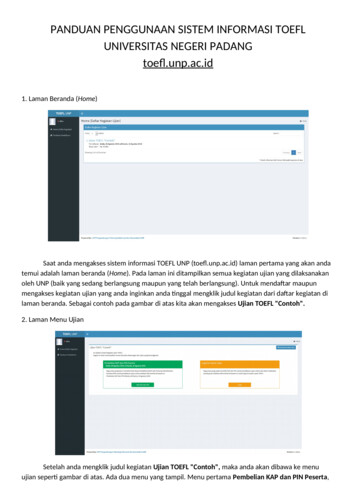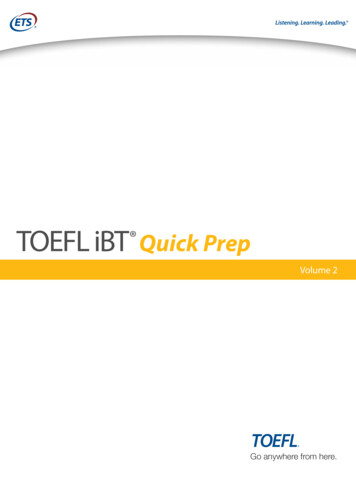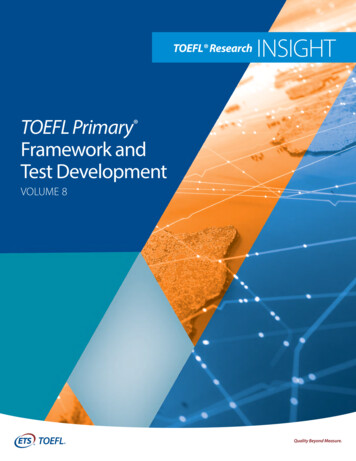
Transcription
TOEFL ResearchINSIGHTTOEFL Primary Framework andTest DevelopmentVOLUME 8TOEFL Research Insight Series, Volume 8: TOEFL Primary Framework and Test Development1
TOEFL Research Insight Series, Volume 8:TOEFL Primary Framework and Test DevelopmentPrefaceThe TOEFL iBT test is the world’s most widely respected English language assessment and is used foradmissions purposes in more than 130 countries, including Australia, Canada, New Zealand, the UnitedKingdom, and the United States. Since its initial launch in 1964, the TOEFL test has undergone several majorrevisions motivated by advances in theories of language ability and changes in English teaching practices.The most recent revision, the TOEFL iBT test, was launched in 2005. It contains a number of innovative designfeatures, including integrated tasks that engage multiple skills to simulate language use in academic settings,and test materials that reflect the reading, listening, speaking, and writing demands of real-world academicenvironments.In addition to the TOEFL iBT test, the TOEFL Family of Assessments has been expanded to provide high-qualityEnglish proficiency assessments for a variety of academic uses and contexts. The TOEFL Young Students Series(YSS) features the TOEFL Primary and TOEFL Junior tests, which are designed to help teachers and learners ofEnglish in school settings. The TOEFL ITP program offers colleges, universities, and others affordable tests forplacement and progress monitoring within English programs.At ETS, we understand that scores from the TOEFL Family of Assessments are used to help make importantdecisions about students, and we would like to keep score users and test takers up-to-date about the researchresults that assure the quality of these scores. Through the publication of the TOEFL Research Insight Series, wewish to communicate to the institutions and English teachers who use any/all of the TOEFL tests about thestrong research and development base that underlies the TOEFL Family of Assessments and to demonstrateour continued commitment to research.Since the 1970’s, the TOEFL test has had a rigorous, productive, and far-ranging research program. But whyshould test score users care about the research base for a test? In short, it is only through a rigorous programof research that a testing company can substantiate claims about what test takers know or can do based ontheir test scores, as well as provide support for the intended uses of assessments. Beyond demonstratingthis critical evidence of test quality, research is also important for enabling innovations in test design andensuring that the needs of test takers and test score users are persistently met. This is why ETS has made theestablishment of a strong research base a fundamental feature underlying the evolution of the TOEFL Familyof Assessments.The TOEFL Family of Assessments is designed, produced, and supported by a world-class team of testdevelopers, educational measurement specialists, statisticians, and researchers in applied linguistics andlanguage testing. Our test developers have advanced degrees in fields such as English, language education,and applied linguistics. They also possess extensive international experience, having taught English oncontinents around the globe. Our research, measurement, and statistics teams include some of the world’smost distinguished scientists and internationally recognized leaders in diverse areas such as test validity,language learning and assessment, and educational measurement.2TOEFL Research Insight Series, Volume 8: TOEFL Primary Framework and Test Development
To date, more than 300 peer-reviewed TOEFL research reports, technical reports, and monographs have beenpublished by ETS, and many more studies on TOEFL tests have appeared in academic journals and bookvolumes. In addition, over 20 TOEFL related research projects are conducted by ETS’s Research & Developmentstaff each year and the TOEFL Committee of Examiners (COE), comprised of language learning and testingexperts from the academic community, funds an annual program of TOEFL research by independent externalresearchers from all over the world.The purpose of the TOEFL Research Insight Series is to provide a comprehensive yet user-friendly account ofthe essential concepts, procedures, and research results that assure the quality of scores for all members ofthe TOEFL Family of Assessments. Topics covered in these volumes include issues of core interest to test users,including how tests were designed, evidence for the reliability and validity of test scores, and research-basedrecommendations for best practices.The close collaboration with TOEFL score users, English language learning and teaching experts, anduniversity scholars in the design of all TOEFL tests has been a cornerstone to their success. Therefore, throughthis publication, we hope to foster an ever-stronger connection with our test users by sharing the rigorousmeasurement and research base and solid test development that continues to ensure the quality of the TOEFLFamily of Assessments.Dr. John NorrisSenior Research DirectorEnglish Language Learning and AssessmentResearch & Development DivisionEducational Testing Service (ETS)TOEFL Research Insight Series, Volume 8: TOEFL Primary Framework and Test Development3
TOEFL Primary Framework and Test DevelopmentIn countries where English is taught as a foreign language, it has become increasingly common foreducational agencies to introduce English language instruction at the earliest grades. This trend reflects agrowing understanding of the benefits of early language learning, as well as the reality of today’s increasinglyglobalized world in which the ability to communicate in English is a bridge to highly valued opportunities inone’s school, workplace, and personal life.Moreover, in countries where English is a main or official language, learners for whom English is not theirfirst or native language receive instruction in English as a second language (ESL). Often, this instruction alsobegins at the earliest grades in primary or elementary school. Given the increasing prevalence of Englishinstruction in the early grades, it is critical to provide high-quality, objective English proficiency measures thatare designed with attention to the unique needs of young learners. The TOEFL Primary tests, targeting Englishlearners ages 8 , were introduced in 2013 to help fill this gap.The TOEFL Primary Test FrameworkThe TOEFL Primary tests are the result of collaboration with leading experts from around the world. Duringthe development of these tests, researchers surveyed existing scientific literature, curricula, standards, andtextbooks to identify key English language knowledge, skills, and abilities (KSAs) and understand the uniquechallenges involved in assessing young English as a Foreign Language (EFL) students. The content and designof the tests were continuously modified and improved on the basis of the findings of a series of prototypingstudies and insights from experts inside and outside ETS. As a standardized international assessment ofEnglish ability, the TOEFL Primary tests are not tied to any specific curriculum. Rather, the tests focus oncommunication skills and activities that are commonly found in EFL instruction for young EFL students.Target PopulationThe TOEFL Primary tests were designed to serve children between 8 and 12 years of age who are both learningEnglish in countries where English is a foreign language and have limited opportunities to use English, eitherinside or outside the classroom. Students in the tests’ intended population are expected to possess a widerange of levels of English language proficiency, as they have different educational experiences and variedaccess to additional language learning support. The TOEFL Primary tests are designed to cover the wide rangeof proficiency levels represented among young EFL learners.Test Purpose and Intended UsesAs independent measures of English communication skills in three areas—reading, listening, and speaking—the TOEFL Primary tests are intended to support teaching and learning by providing meaningful feedback thatteachers can incorporate into their instruction. Test scores may be used to: assess the general English language proficiency of young students ages 8 obtain a snapshot of each student’s ability in listening, reading, and speaking understand students’ abilities in relation to a widely accepted international standardIt is not desirable to use TOEFL Primary test scores for high-stakes decisions, such as admitting students,evaluating teachers, and comparing or ranking individual students.4TOEFL Research Insight Series, Volume 8: TOEFL Primary Framework and Test Development
Test ContentThe TOEFL Primary tests measure young EFL students’ ability to communicate in English in three modalities—reading, listening, and speaking. The TOEFL Primary Reading and Listening test sections must be takentogether as a single test. The TOEFL Primary Speaking test is taken as an independent test. Each testfocuses on the ability to use English in accomplishing communication goals in familiar and age-appropriatecontexts. Thus, the test tasks used in the TOEFL Primary tests were designed to resemble real-life languageuse situations that students are likely to encounter in learning English, as well as measure enabling languageknowledge and skills that support the development of communication ability.TOEFL Primary Reading TestThis section measures the ability to use English to achieve the following communication goals: Identify people, objects, and actions Understand commonly occurring nonlinear written texts (e.g., signs, schedules) Understand written directions and procedures Understand short, personal correspondence (e.g., letters) Understand simple, written narratives (e.g., stories) Understand written expository or informational texts about familiar people, objects, animals, and placesTo achieve these goals, young EFL students need the following enabling knowledge and skills: Recognize the written English alphabet and sounds associated with each letter Identify words based on sounds Recognize the mechanical conventions of written English Recognize basic vocabulary Process basic grammar Identify the meaning of written words through context Recognize the organizational features of various text typesTOEFL Primary Listening TestThis section measures test takers’ ability to use English to achieve the following communication goals: Understand simple descriptions of familiar people and objects Understand spoken directions and procedures Understand dialogues or conversations Understand spoken stories Understand short informational texts related to daily life (e.g., phone messages, announcements) Understand simple teacher talks on academic topicsTOEFL Research Insight Series, Volume 8: TOEFL Primary Framework and Test Development5
To achieve these goals, young EFL students need the following enabling knowledge and skills: Recognize and distinguish English phonemes Comprehend commonly used expressions and phrases Understand very common vocabulary and function words Identify the meaning of spoken words through context Understand basic sentence structure and grammar Understand the use of intonation, stress, and pauses to convey meaning Recognize organizational features of conversations, spoken stories, and teacher talksTOEFL Primary Speaking TestThis test measures test takers’ ability to use English to achieve the following communication goals: Express basic emotions and feelings Describe people, objects, animals, places, and activities Explain and sequence simple events Make simple requests Give short commands and directions Ask and answer questionsTo achieve these goals, young EFL students need the following enabling knowledge and skills: Pronounce words clearly Use intonation, stress, and pauses to pace speech and convey meaning Use basic vocabulary and common and courteous expressions Use simple connectors (e.g., and, then)Test Structure and FormatDepending on school curricula and other factors, young students acquire their English abilities at differenttimes and in different ways. The TOEFL Primary program offers 3 tests to measure a range of skills in eachmodality. The Reading and Listening tests are available at two difficulty levels (Step 1 and Step 2). TheSpeaking test is a single-level test that both Step 1 and Step 2 test takers can take.The TOEFL Primary Reading and Listening tests include three-option multiple-choice items, pictures, and avariety of text types in order to keep students engaged and focused while taking the test.6TOEFL Research Insight Series, Volume 8: TOEFL Primary Framework and Test Development
Table 1. TOEFL Primary Reading and Listening Test — Step 1*TestNumber ofQuestionsNumber ofExamplesTotal Number ofQuestionsTimeReading SectionListening Section363635394130 min30 min*Paper or digitally deliveredTable 2. TOEFL Primary Reading and Listening Test — Step 2*TestNumber ofQuestionsNumber ofExamplesTotal Number ofQuestionsTimeReading SectionListening Section363613373930 min30 min*Paper or digitally deliveredThe TOEFL Primary Speaking test includes 7 constructed-response items that are presented in a scenario.During the Speaking test, students speak to multiple fictional virtual characters. Animations, playfulcharacters, and whimsical content are used to keep students engaged and elicit more spontaneous andnatural responses.Table 3. TOEFL Primary Speaking Test*TestNumber of QuestionsTimeSpeaking720 min*Paper or digitally deliveredTest DevelopmentETS maintains a continuous and rigorous process of producing and vetting new items and test content for theTOEFL Primary tests.Content Development StaffThe TOEFL program maintains high standards for test content developers, using only carefully selected,highly qualified staff to write items and create content for the TOEFL Primary tests. All members of the testdevelopment staff are thoroughly trained in the process of authoring quality items. In addition, they allhave formal university-level training in language learning or related subject areas. The majority of ETS’s testdevelopment staff hold graduate-level degrees from English-medium universities and have taught at schoolsor universities internationally.TOEFL Research Insight Series, Volume 8: TOEFL Primary Framework and Test Development7
Item WritingIn order to ensure that the test content is as comparable as possible across all administrations of theTOEFL Primary tests, each item writer follows detailed item writing guidelines when creating test questionsand other test content, such as reading passages or lectures. They make sure test questions and content: are clear and coherent; are culturally accessible and appropriate; are at an appropriate level of difficulty; do not require background knowledge in order to be comprehensible; align with ETS fairness guidelines; and contain sufficient testable content.These principles are fundamental to all TOEFL Primary test development processes.Item Review ProcessAll items used on the TOEFL Primary tests are subject to a rigorous review process, including content, fairness,and editorial reviews.Content ReviewBefore an item is considered fit for operational use, it has to pass a rigorous quality control process thatconsists of two key review stages: content review and fairness review. Upon completion of the first rough draftof an item, the item writer sends the item into content review. At the content review stage, differentTOEFL Primary assessment development specialists will answer the item like a test taker and thenindependently revise the item to improve quality. Each change is documented in the comments section ofthe database for subsequent reviewers. Ultimately, the item writer revises the item based on the commentaryprovided. Multiple iterations of content review are conducted until all review comments are addressed and nofurther issues are flagged. The reviews focus on questions such as these: Is the language in the test materials clear? Is it accessible to a nonnative speaker of English in ourtarget population? Is it age appropriate? Is the content of the stimulus accessible to nonnative speakers who lack specialized knowledge abouta given topic?For multiple-choice questions, reviewers also consider the following factors:8 the appropriateness of the point tested the uniqueness of the answer or answers the clarity and accessibility of the language used the plausibility and attractiveness of the incorrect answer choicesTOEFL Research Insight Series, Volume 8: TOEFL Primary Framework and Test Development
For constructed-response items in the TOEFL Primary Speaking test, the review process is similar but notidentical. Reviewers tend to focus on accessibility, clarity in the language used, and how well they believe theparticular Speaking item will generate a fair and scorable response. It is also essential that reviewers judgeeach Speaking item to be comparable with others in terms of difficulty. Expert judgment plays a major role indeciding whether a Speaking item is acceptable and can be included in an operational test.Fairness ReviewAfter an item has successfully passed the content review stage, it enters fairness review—a process thatensures that items are fair and equitable to test takers of all cultural and ethnic backgrounds.The ETS Standards for Quality and Fairness (ETS, 2014) mandate fairness reviews. This fairness review must takeplace before a test item is administered to test takers. All ETS test developers undergo fairness training (inaddition to item writing training) soon after their arrival at ETS. As part of their training, item writers becomefamiliar with the ETS Guidelines for Fairness Review of Assessments (ETS, 2016a) and the ETS InternationalPrinciples for Fairness Review of Assessments (ETS, 2016b) and use them when developing and reviewingtest content. Although fairness issues are considered at each stage of the development process, they areparticularly focused on at the fairness review stage.During fairness review, specially trained fairness reviewers conduct an independent review of allTOEFL Primary test materials. TOEFL Primary test developers may not perform this official fairness review;the official fairness reviewer is typically a test developer who works on other ETS tests. In this way, the fairnessreview is more objective. When fairness reviewers find unacceptable content in the test materials, they issuea fairness challenge. A content reviewer must then work with the fairness reviewer to resolve the challenge tothe satisfaction of both reviewers. For rare cases in which the reviewers cannot reach agreement, a panel ofboth content and fairness reviewers decides on the issues at hand and comes to a resolution.Editorial ReviewAll TOEFL Primary test materials also receive an editorial review. The purpose of this review is to ensure thatlanguage in the test materials is clear, concise, and consistent. Editors ensure that established ETS test style isfollowed. All suggestions for changes need to be approved by the content specialist for the given test section.Item Pretesting and TryoutTOEFL Primary Reading and Listening TestAll TOEFL Primary multiple-choice test items are pretested with a large number of test takers. Pretest items areincluded in operational forms, and data are collected on real TOEFL Primary test takers’ ability to answer theitems. Test takers cannot identify pretest items because they do not differ in any distinguishable way from theoperational (i.e., scored) items on the test. Pretesting items allow test developers to identify poorly functioningitems and revise or exclude them from the operational item pool. Test developers review data from itempretesting and use the information to refine their understanding of what makes a good test item.TOEFL Research Insight Series, Volume 8: TOEFL Primary Framework and Test Development9
TOEFL Primary Speaking TestIn operational administrations, the TOEFL Primary Speaking test does not contain embedded pretest items.Instead, ETS conducts small-scale tryouts of Speaking items with young English language learners. Testdevelopers review and evaluate spoken responses to these tryout questions, using expert judgment todetermine which prompts are likely to elicit valid and scorable responses from test takers across the range ofproficiency levels. These viable prompts are the ones that appear in operational test forms.ScoringTOEFL Primary Reading and Listening TestsThese tests are scored locally by ETS’s Preferred Network offices. The test scores are determined by thenumber of questions a student has answered correctly. There is no penalty for wrong answers. The numberof correct responses on each section is then converted to a scaled score of 101–109 points for Step 1 and104–115 for Step 2. This is done using a statistical procedure that takes “raw” scores obtained on each sectionand transforms or adjusts them to a standardized scale. Transforming raw scores into scaled scores allows forcomparison of scores across different test administrations.TOEFL Primary Speaking TestResponses to the TOEFL Primary Speaking test are scored by human raters at ETS using scoring rubrics witheither a 0–3 point scale or a 0–5 point scale, depending on the task type. The range of speaking scores is0–27. The scoring rubrics were developed based on performance data collected in the pilot and field testadministrations of the test. The rubrics identify three major dimensions that are taken into consideration—language use, content, and delivery—with each dimension considered in relation to the clarity of overallmeaning. Despite the fact that three dimensions are considered, only one “holistic” score is assigned toeach response.Scoring Speaking responses presents challenges that multiple-choice testing does not. Whereas multiplechoice tests can be scored objectively, rating speaking performances relies on human judgment. ETS supportsscoring quality and consistency for the TOEFL Primary Speaking test in a number of ways:10 Raters must be qualified. In general, they must be experienced teachers, ESL or EFL specialists, or inpossession of other relevant experience. In addition to teaching experience, ETS prefers raters whohave master’s degrees and experience assessing spoken and written language. If they have the formal qualifications, raters are then trained. ETS trains raters using a web-basedsystem. Following their training, raters must pass a certification test in order to be eligible to score. Toassure reliability of constructed-response scoring, ETS monitors raters continuously as they score. Nonnative speakers of English may be raters and, in fact, contribute a much-needed perspective to therater pool, but they must pass the same certification test as native-speaking raters. The scoring process is centralized, and it is performed separately from the test center administrationin order to ensure that test data are not compromised. Through centralized, separate scoring, eachscoring step is closely monitored to ensure its security, fairness, and integrity. ETS uses its patented Online Network for Evaluation to distribute test takers’ responses to raters,record ratings, and monitor rating quality constantly.TOEFL Research Insight Series, Volume 8: TOEFL Primary Framework and Test Development
At the beginning of each rating session, raters must pass a calibration test for the specific task type they will ratebefore they proceed to operational scoring. Scoring leaders—the scoring session supervisors—monitor raters in realtime, throughout the day. These supervisors also regularly work as raters on different scoring shifts and are subjectto the same monitoring. No rater, no matter how experienced, scores without supervision. ETS test developers alsomonitor rating quality and communicate with scoring leaders during rating sessions.For each administration, ETS’s Online Network for Evaluation sends Speaking responses to multiple independent ratersfor scoring. Each test taker’s responses are scored by more than one rater. When a discrepancy between raters arises, itis resolved by a third rater.Score ReportingAfter taking the TOEFL Primary tests, students receive score reports and certificates of achievement, while schoolsand teachers receive a group-level score report for their students. These reports provide detailed and comprehensiveinformation regarding students’ performance on the test.Individual score reports provide a variety of information: Numeric scores for each skill to help measure progress Band level and performance descriptors to provide meaningful descriptive information and recommendnext steps that students can take to improve their English language abilities Lexile scores to help identify reading materials that match students’ current reading levels Common European Framework of Reference (CEFR) levels to help interpret students’ abilities in relation toan international English language proficiency standardA group-level score report is available for teachers and schools to view their students’ performance and keeptrack of progress.Ongoing OversightOngoing oversight is a key feature of the TOEFL Family of Assessments. The TOEFL Primary tests undergo regularinternal audits every three years. The auditors evaluate compliance with ETS’s Standards for Quality and Fairness andreport directly to the ETS Board of Trustees on any issues they may find.Additionally, the COE provides guidance and oversight for research and development related to all tests in theTOEFL Family of Assessments. The COE is a panel of 12 experts from around the world, each of whom has achievedprofessional recognition in an academic field related to learning and testing English as a second or foreign language.The TOEFL YSS Subcommittee of the COE consists of three individuals with specialized expertise in the education andassessment of young learners. They advise on research and development efforts related to the TOEFL Primary tests.TOEFL Research Insight Series, Volume 8: TOEFL Primary Framework and Test Development11
ReferencesEducational Testing Service. (2014). ETS standards for quality and fairness. Princeton, NJ: Author.Educational Testing Service. (2016a). ETS guidelines for fairness of assessments. Princeton, NJ: Author.Educational Testing Service. (2016b). ETS international principles for fairness of assessments. Princeton, NJ: Author.Copyright 2019 by Educational Testing Service. All rights reserved. ETS, the ETS logo, TOEFL, TOEFL iBT, TOEFL ITP, TOEFL JUNIOR and TOEFL PRIMARY are registered trademarks of Educational Testing Service (ETS).All other trademarks are property of their respective owners. 4189912TOEFL Research Insight Series, Volume 8: TOEFL Primary Framework and Test Development
2 TOEFL Research nsight Series Volme TOEFL rimary Framework and Test evelopment TOEFL Research Insight Series, Volume 8: TOEFL Primary Framework and Test Development Preface The TOEFL iBT test is the world's most widely respected English language assessment and is used for admissions purposes in more than 130 countries, including Australia, Canada, New Zealand, the United
